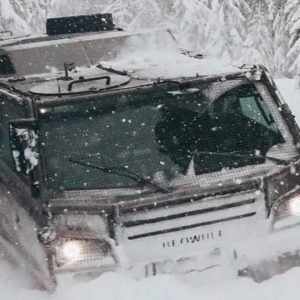
The UK has reaffirmed its indefinite commitment to the support of Ukraine’s ongoing war against Russia through 2025, which could see an expansion of a little-known military training mission inside Ukraine’s borders, to more quickly provide troops for the frontline.
To date, the UK has maintained a small training presence inside Ukraine for some time, a small part of a wider commitment to Ukraine that has seen £12.8bn ($16bn) in funds and equipment provided since 2022, including hundreds of artillery pieces, main battle tanks, and other armoured vehicles, including the Scimitar light tank.
Speaking to the House of Commons on 19 December, Luke Pollard, Minister for the Armed Forces, said the UK would provide £3bn per year “as long as Ukraine needs”, while at the same time the Ministry of Defence announced a new £225m package of military support. Including in the package were the “latest generation of uncrewed surface vessels, loitering munitions, and mine countermeasure drones”.
In addition, air defence equipment including new radars, decoy land equipment, and counter-drone electronic warfare systems were also to be provided.
However, with the UK’s own inventory hugely depleted of platforms it can provide to Ukraine – having already donated its AS90 155mm artillery, Scimitar light tanks, and other legacy vehicles – it is in training that London still has the ability to offer a force multiplier to Kyiv.
The UK’s Operation Interflex has trained more than 50,000 Ukrainian recruits at secret locations in England, with assistance from military trainers from countries such as Norway through the JEF security initiative.
Access the most comprehensive Company Profiles
on the market, powered by GlobalData. Save hours of research. Gain competitive edge.

Company Profile – free
sample
Your download email will arrive shortly
We are confident about the
unique
quality of our Company Profiles. However, we want you to make the most
beneficial
decision for your business, so we offer a free sample that you can download by
submitting the below form
By GlobalData

The next step could see a significant expansion of UK training presence in Ukraine to more quickly provide Ukrainian recruits with basic battlefield skills, removing the transit time between countries and acclimatisation process.
Speaking to the BBC, UK Defence Secretary John Healey did not rule out the notion of sending additional UK military trainers into Ukraine next year.
One concern is that Russia could seek to target an expanded UK presence in Ukraine via its significant supply of long-range strike weapons, including loitering munitions and intermediate range ballistic missiles (IRBMs).
“We will continue to provide the training that Ukraine needs and be flexible to meet their requirements,” said Pollard.
Situation “difficult” in Pokrovsk and Kurakhove
Meanwhile, ongoing offensive operations by Russia in Ukraine continue to achieve tactical gains around Pokrovsk, Kurakhove, and Velyka Novosilka. A key target by Russia troops since 2022, recent operations near Velyka Novosilka have seen two of the three main supply routes into the town severed.
Moscow has pushed to around 2km east of Pokrovsk, whose capture would be the latest in a year of grinding successes for Russia, which captured Avdiivka in February, having also seized Bakhmut in 2023.
Russia’s losses in 2024 have been significant, with Western officials stating that Russian forces are sustaining around 1,500 military casualties per day in December, maintaining a current trend of high monthly levels of personnel killed and wounded in action.
The deployment of some 11,000 North Korean troops into the Kursk region of Russia to help Moscow repel a Ukrainian counterattack has also suffered some losses, although exact numbers are difficult to determine.
A recent statement by Ukrainian President Volodymyr Zelenskyy said the situation in Kursk “remains difficult” in the Pokrovsk sector and Kurakhove. In addition, it is understood that Ukraine’s hold of Russian territory in the Kursk Oblast has reduced to 500km2, down from 900km2 at its peak, as a result of ongoing Russian and North Korean operations.
During Pollard’s speech to the House of Commons on 19 December, he said that 750,000 Russian military personnel had been killed or wounded since February 2022, with the expectations that this would surpass the one million mark “within the next six months”.
However, Moscow is currently deemed able to sustain such losses and has not yet had to undertake a wider moblisation programme, with existing incentives successful in filling personnel gaps.
By contrast, Ukraine is struggling to mobilise enough of its own personnel to meet its requirements, with the age of conscription in 2024 dropping to 25 in a bid to draw in more recruits.
In September, Army Technology was in the western city of Lviv to learn more about the Ukrainian Ministry of Defence’s Army+ app, which has been created in a bid to streamline recruitment processes which could also see conscription notifications sent out by text message, rather than physical letter, to improve efficiencies.
The exemption process, through which Ukrainian’s can request not to be drafted due to ongoing study or medical reasons, has also been digitised.
The average age of Ukrainian personnel on the frontlines has mainly seen those in their late-30’s and 40’s performing most of the combat, although this is reducing through attrition, soldiers killed or injured, and the age of new recruits and draftees.
Russia loses 1,000 tanks in 11 months
The UK Ministry of Defenceon 17 December said that Russia is increasingly turning to the use of older military stocks in its inventory, having lost an estimated 3,600 main battle tanks (MBT) and nearly 8,000 armoured vehicles since February 2022.
By 25 January 2024, it was assessed that Russian ground forces had likely lost around 2,600 MBTs and some 4,900 other armoured vehicles, indicating the loss of 1,000 tanks and over 3,000 armoured and infantry fighting vehicles in the past 11 months.
Imagery provided by the UK shows what it says a depleted stocks of Russian armoured vehicles as a result of ongoing war attrition.

It is not possible to independently verify the claims of Russian losses, with official UK figures tallying close to those claimed by Ukraine. The US Department of Defense generally cites lower figures, although these are also impossible to independently confirm.
However, Russia is widely understood to be able to accommodate such losses, generating some 100 MBTs per month from refurbishing existing stock and new build platforms.
Ukraine’s own losses of personnel and military equipment is held at state secret level, although the tempo and duration of its war against Russia will have seen it sustain tens, possibly hundreds of thousands of casualties and thousands of MBTs, armoured vehicles, and other equipment, destroyed in combat.
Open-source intelligence analysis has confirmed that much UK-provided equipment, including at least one Challenger 2 MBT, has been destroyed in fighting.








